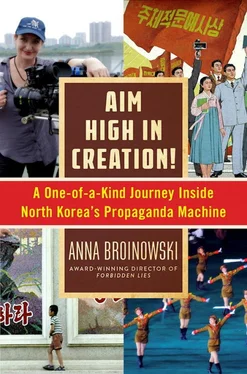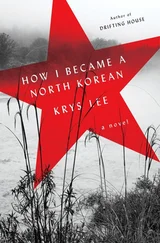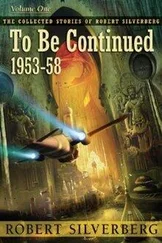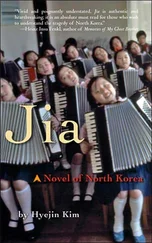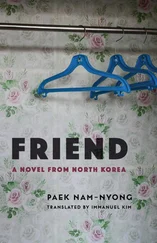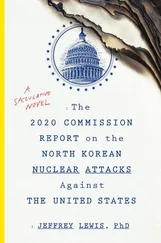The demilitarized zone is 250 kilometres long, four kilometres wide, and, despite its name, the most heavily armed border on earth. Because the Korean War ended in a ceasefire rather than a peace treaty, America and North Korea are still technically at war. Their armies stand ready to strike at the merest provocation, and the DMZ is booby-trapped with a million landmines. In the Joint Security Area in Panmunjom, the two Koreas face each other across a painted white line. Soldiers on both sides will shoot dead anyone who tries to cross it.
“What’s her movie about?” the soldier asks our driver.
“Something to do with gas mines destroying her land,” he mumbles, “but we won’t get to see it.”
The soldier digests this as we pull up outside the Joint Security Area gate. “Why can’t we see it? What’s wrong with it?” he wants to know.
“If I tell you, we’d get into trouble,” says the driver, and orders us out of the van. He’s not allowed to drive any further: we must walk the rest of the way.
“You can’t take that with you,” the soldier says, frowning at our Sony. Apparently, the camera is too big. Nic picks up her mini DV instead, and we follow our minders into the guard post. As busloads of Chinese tourists walk freely through the gate, Ms. K negotiates with an obstinate guard, increasingly flustered. Even without our professional camera, Nic and I are still Western media. Whatever permit we have, it’s not enough. “They need an access fee,” Ms. K says, looking unusually rattled. I fish out what’s left of our petty cash, and she hands it over. The guard barks something at Ms. K, and she stays in the guard post as Q, Sun Hi, Nic, and I walk through.
“Do not walk anywhere except where I tell you!” a twenty-something soldier with matinee-idol looks instructs the tourists in fluent Mandarin. We fall into single file. It’s not a difficult order to follow: since 1953, skirmishes over this small patch of land have killed five hundred South Koreans, fifty Americans, an unknown number of North Koreans, a few defectors, and one tourist—who wandered into the bushes to do yoga one day and was promptly shot. Despite this, the path we’re filing along is pretty and serene. Birds sing in thickets above our heads, and wildflowers line the paving stones. Every fifteen metres, as if to remind us we’re not in a nature reserve, a soldier stands to attention with his rifle against his chest, gazing sternly into space.
“This is a monument to the glorious Korean People’s Army fight for freedom,” our soldier-guide says, pointing at a megalith on a viewing platform above the Joint Security Area. “Its total length is 9.4 metres, which signifies the year it was built by our Great Leader. The height is 4.15 metres, which signifies the date of birth of our Great Leader. At the bottom you can see our national flower, Magnolia sieboldii .” The tourists lean forward to snap the flower—but Nic and I film the South Korean viewing platform facing us across the valley. It has coin-operated binoculars and fronts a modern glass building. Two decades ago, I stood there with my father, trying to spot North Koreans. Now I’m surrounded by them—and the South Koreans are weirdly absent. Perhaps they have better things to do out there in the free world. Seoul is only sixty-two kilometres away, but all I can see of it from here is a line of gently undulating hills.
If it weren’t for the observation towers, the DMZ would look a lot like a national park. Unofficially, it is. The place has been deadly to humans, but a godsend for animals. For six decades, they’ve roamed freely between the fortified fences—creating what ecologists now recognize as one of the most significant temperate habitats in the world. There are 2,900 plant species, 320 kinds of birds, and seventy different mammals thriving in the mountains, prairies, and marshlands of this accidental wildlife sanctuary—including the near-extinct Korean tiger, Amur leopard, Asiatic bear, and the icon of North Asian art, the red-crowned crane. Just as Chernobyl proved in the 1980s, the removal of humans from the food chain can do wonderful things for nature. In 2005, the DMZ’s beauty so captivated CNN media mogul Ted Turner, he offered to finance any plan to turn it into a peace park and UN-protected World Heritage Site.
That’s not happening anytime soon, judging from the firepower on display in the Joint Security Area. We follow our soldier-guide down to a row of deceptively humble blue cement huts on a neat concrete square. The place is oppressively quiet and crackling with tension. South Korean soldiers, in high-tech camouflage uniforms, glare at their distinctly poorer cousins across the white demarcation line. Their grim, robotic postures make them look like actors in a particularly pretentious interpretive dance. If it weren’t for their guns, I’d be giggling. As it is, I join the tourists in the main hut in respectful silence. The table the American and North Korean generals sat around when armistice negotiations began in 1951 has been perfectly preserved—right down to the miniature flagpoles and microphones positioned on each side of the line. Horrifically, both powers continued to kill Korean civilians while conducting these talks, one of the sadder facts about the Forgotten War. I pose for Nic in the chair where US Lieutenant General William K. Harrison, Junior sat, making sure the North Korean soldier behind me is in frame. A South Korean soldier faces him through the window, stiff and blank. Neither flinches when Nic’s camera flashes. They are brilliant at pretending we’re not there.
We move on to Armistice House, a gabled Korean manor surrounded by lush gardens. “On 25 June 1950, America invaded North Korea,” states our soldier-guide solemnly. “After sustaining significant damage, America suggested talks. Right here is where the agreement was signed.” There is a long table covered in green baize, framed by the flags of America and its allies. The walls are hung with photographs of Kim Il Sung talking with the enemy brass and detailed charts of American war crimes. I walk into the sun, overwhelmed by the insanity of war. There are no benches to sit on, but a small stone plinth offers a comfortable ledge. I perch on it and take out my Inner West Argus . A snap of Australian CSG protests in the middle of the DMZ, I figure, will make for an interesting contrast. “How dare she sit there?” someone yells in Korean—and a dog barks in the distance. I look up from the paper to see Q hurrying towards me, gesturing frantically for me to stand.
Apparently, I’ve committed a major crime: the writing on the plinth is as sacred as Kim Jong Il. Sun Hi, shaky with fear, translates: “The American imperialists, instigators of a provocation raid on Korea, knelt down before the heroic People of Korea and signed the armistice agreement here on 27 July 1953.” My incursion has had one advantage: it’s compelled our handsome guide to leave the tourists to investigate. “Exactly what movie are you making here?” he asks, alert behind his smile.
“It’s about evil capitalists destroying her farms,” Sun Hi says quickly, before I can answer.
The soldier stops smiling. “She must delete the image with the foreign newspaper on our monument,” he says.
“The article is only about Australian gas drilling,” I reason. “It’s not about your country. In fact, I’m making a film in your style, to stop the mines.”
He raises his beautiful brows in surprise. “You like our films?” His curiosity betrays his innocence. He can’t be more than twenty-two.
“What do you think of my country?” he asks. I tell him that I think his people, and their films, are wonderful. “What do you think of Australia?” I fire back.
The soldier breathes in sharply, and rocks on his heels. “I’m going to get in trouble for this, aren’t I?” he mumbles to Q. I’m not sure why he’s deferring to Q: in his casual shirt and grey slacks, Q is not a Party official, or even a designated guide. He is just our gaffer—an Average Joe from Pyongyang. But from the nervous way the soldier awaits Q’s response, it seems that Q has real power.
Читать дальше
